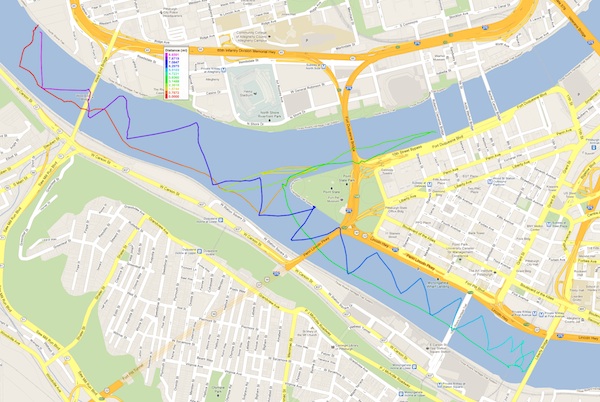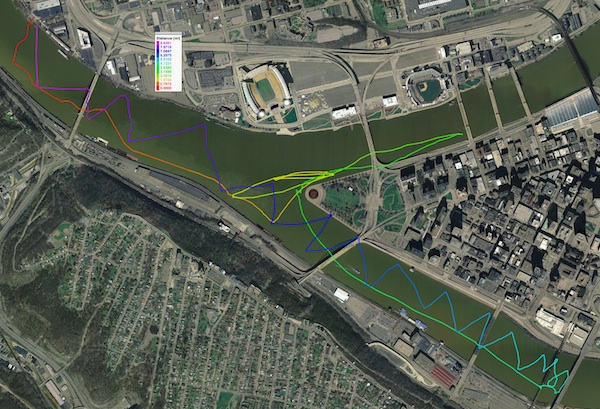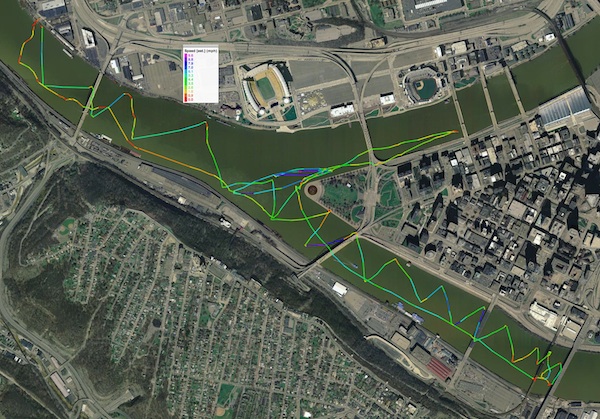Caught
August 1, 2012
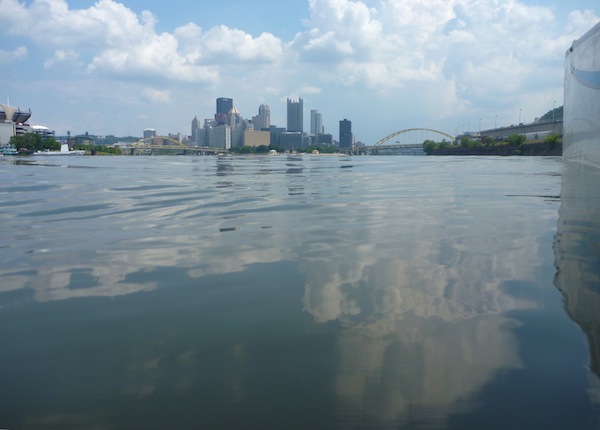
It was now time to put the bigger Hobie Getaway sailboat into the river. So far this summer, I've been sailing the small Bravo. It can carry two if they are good friends, as it did recently, but it is really best sized for just one. Tom Pashby had told me last summer that he'd like to join me sailing on the river. This fortunate offer had gotten lost in some corner of my brain, until he reminded me again sometime last Fall.
This past summer has not been the best for sailing. There's been too much heat and too little wind. So I was willing to settle for less wind. It is better than nothing. This Wednesday August 1 looked promising enough. The forecasts called for 6-7 mph winds from a good direction, the Northwest. Winds from that direction can blow unobstructed straight up the Ohio and Mon rivers:
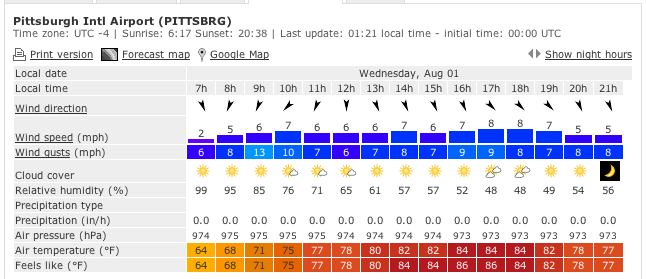
Temperatures were forecast to be in the lower 80's F (and that's what happened). Those temperatures are hotter than I like, but they are manageable.
The river flows had been high. On Saturday on the Ohio River they had been up over 30,000 cubic feet per second, which is over my limit for sailing.
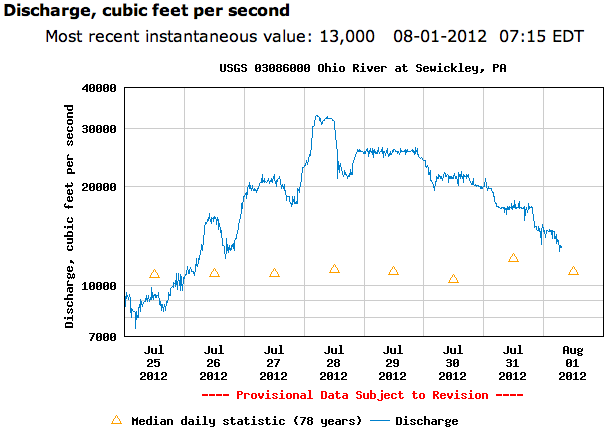
It was due to a major release of water upstream on the Allegheny, as I found by probing the Army Corps of Engineers plots further:
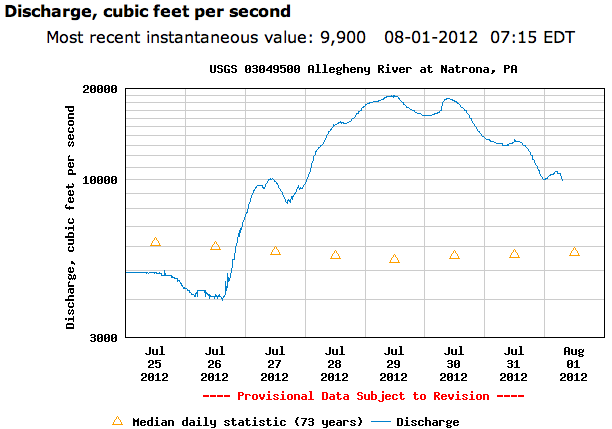
I could see on Tuesday that the flows were dropping. The trend continued so that by Wednesday afternoon, they had dipped below 13,000 cubic feet per second on the Ohio. That is fine for sailing, even in very light winds. (Here's the Mon flow--too small for concern.)
Tom, his friend Jean and I picked up the Getaway from its garage late morning and trailered it down to the Newport Marina on the Northside. We then took up the hot and wretched business of stepping the mast and rigging the boat. Stepping the mast is the worst job. The mast looks like a little stick. But it is not. It is a big heavy beam that needs two people at a minimum to haul upright.
Then there's the ever awkward job of pinning the forestay. That's the wire that runs from high on the mast to the bow and keeps the mast upright. The jib--the small sail at the front--is rolled around it. A metal tongue has to be slid into a slot and pinned in place while holding back the weight of the mast. It is a juggle that needs four hands. This is one part of Hobie design that really could use some attention.
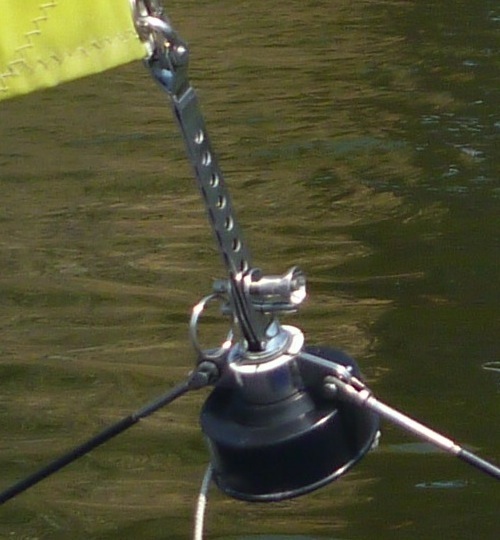
There's a moment of relief when the forestay is pinned and the mast is up and stable. "Good, that's over," is the universal feeling. Here are Tom and Jean after the deed is done. It is to their great credit that they are smiling.
Next came the tricky maneuver of backing the trailer down the boat ramp into the water. I understand the geometry and physics of this maneuver well. It is a pseudo-stable system. The slightest uncorrected turn from the intended course is magnified if you don't immediately correct it. Nonetheless, this understanding does not translate into any special facility. It took a long time to get the boat down the ramp into the water. The operation was complicated by an overhanging tree that caught in the mast and sail and gave the deck some greenery and twigs.
Here we are. Ready to go:
We put into the water at about 1:15pm. We'd been eyeing the water. There was only little visible current. It was noticeable as a lazy drift of debris in the water. That slight current would present no problem if we had any wind. There was just a little wind. It was revealed by tiny ripples out in the river.
We set out, just in time for that feeble wind to die. The next hour and a bit was spent sitting on a hot deck, creeping slowly towards the Point. A gentle puff would move us a few yards. Then it would die and we'd drift slowly back. Then the next would come. Each cycle would get us a little farther up the river.
The unspoken thought was that we might just be better off back at the dock with a cool drink under the shade of a tree. But then there was always the hope that the next few minutes would bring a breeze. I was overheated from the work of rigging the boat . Since Tom had the tiller and we weren't moving, this seemed a good time for a cooling swim.
So I slid off the deck and immersed myself in the river. It was the temperature of a lukewarm bath, but just what I needed. I had forgotten, however, that the boat deck is high enough to make it quite a struggle to get back on board. With a hand from Tom, I eventually managed it. (Note for next time: make a loop for my foot in a docking line cast over the bow. That would give me enough height to get onto the deck by myself!)
We edged towards the Point, passing the West End Bridge.
Tom has the tiller and Jean is working the blue jib sheets. I am taking advantage of being a mere passenger to take photos. I put my little camera over the side as close to the water as I can get it. The barges docked at the river's edge start to look as big as they really are when seen from this water-bug's eye view.
Here's the Point, seen over glassy still water, with the Hobie's hull on the right.

At around 2:30 pm, we arrived at the Point. By then, the winds were starting to pick up and we began to wonder if we might get some real sailing after all.
We had company at the Point.
The winds freshened, blowing roughly from the Northwest. We took a few tacks back and forth, enjoying the feeling of moving under the magical power of the wind. Here we have the wake raised by the boat when we are making 8 or 9 mph.
Which way should we go? Allegheny or Mon? Wherever the wind is best! First we tried the Allegheny River. Here we are approaching the Fort Duquesne Bridge.
As we pass under it, I snap a photo directly upwards.
"I surveyed all the bridges on the rivers," I said to Tom. "We easily fit under all of them. You'd need to be the Cutty Sark to get into trouble!" I was going to continue with a professorial lecture on the last of the great tea clippers. But who wants to be stuck on the river for hours with a too chatty professor?
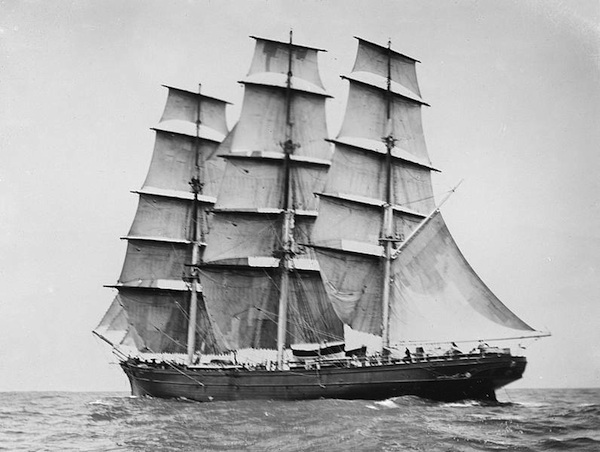
"Oh," I felt duty bound to add, "There is one bridge on the Mon with a span we won't pass under." We had found it the very first time we sailed the rivers. We'd been so spooked by a barge that we went to the other side of the river and kept our eyes on the barge. We ran straight into the low span of the Port Authority's Transit Bridge, just downstream of the Liberty Bridge.
"How did you get free?" Tom asked. "The wind was pressing us against the bridge, but we could slide along to a gap and be blown through."
I chuckled with the smugness of someone who has experienced it all and is just too good now to be caught again.
Here's the Port Authority's Transit Bridge, from upstream, with the low span on the left.

We made it up the Allegheny about as far as PNC Park. The winds were blowing roughly from the North, so we sailed on a pleasant beam reach.
On that point of sail, the wind comes from the side ("beam"). It is the best point of sail for a sailboat with a fore-aft sail. No tacking is needed. The quietening wind soon convinced us to head back. Its Northerly component meant it was blocked by the Northern shore of the river. You can see the water going glassy here from the calmness of the air:
We soon rounded the Point and headed down the Mon. We passed the Fort Pitt Bridge:
Then the riverboats docked at Station Square:
Here's the Smithfield Street Bridge.
It's fast, easy sailing. We are on a run with the wind behind us. So there's no delicate tacking. I'm enjoying being a passenger who does not need to pay much attention. I'm playing with the idea of putting my camera right on the water to put a better sense into the image of what it feels like to be on the water.
I've now rolled over and I'm looking ahead. It's easy to pop off another photo. Here's where we are heading:
Dear reader, does this look familiar? This is the PA Transit Bride! We are heading straight for the one span under which we cannot pass. And here I am taking a leisurely photograph of it!
What I have just done is the equivalent of a lookout on the Titanic, seeing the iceberg dead ahead, and fetching his camera to take a snapshot for the family album. Calling the alarm would have been a better idea.
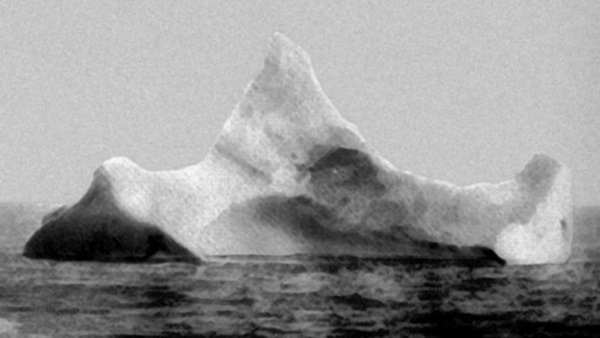
The next thing I knew, the bows abruptly raised up and fell down. It felt as it we'd run over something big and bulky in the water. I looked down, but there was nothing to see. We then looked up and saw what we had done. We were under the bridge with the mast poking into the ironwork.
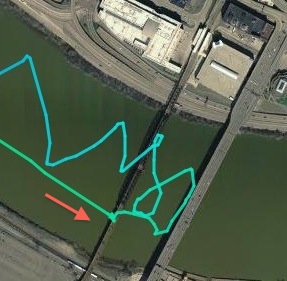
At first I thought we might paddle back out. We rolled up the jib and dropped the sail to take the pressure off the mast. We then tried paddling this way and that, while I leaned on the shrouds (the wires holding the mast) in the hope that it would take a few precious inches off the vertical height of the mast.
The problem was the "Hobie Bob" float at the top of the mast. If the boat tips, that float stops the boat turning turtle, with the mast pointing down into the water. It is a great safety feature but now it is what was catching. We were caught in a triangle of steel beams. If we moved in any direction, the beams caught under the Hobie Bob.
While we pondered what to do, I tried to snap another photo:
The sun is in the frame, but you can see enough to sense our deep trouble. This was much worse than the first time, years ago, when we'd run into this bridge. This time we were...
CAUGHT!
We pondered our plight. Tom first had the right, if frightening, thought. "Perhaps we should drop the mast?" Yes. That would solve the problem. But how do we get it up again in the middle of the river?
Soon a plan formed. We needed to relax the forestay only a few feet to get the clearance needed. We would use the blue docking line you see in the photo to extend the forestay.
Tom and Jean unpinned the forestay and replaced the regular fitting with a length of docking line, firmly tied to the main beam at the bow. While they did this, I held the mast upright. When it was tied off, I gingerly took the weight of the mast and let it tip backwards. This was something I never imagined I would do in the middle of the river. Tom then paddled with energy and fury. "Don't stop--just keep paddling--I need to get this weight off my shoulder!" We cleared the bridge and I pushed the mast back upright. Tom and Jean fiddled with the forestay and it was over.
We sat back on the deck with the nervous animation of people who had suddenly been thrown into unexpected peril and were now too cautious to believe that it was passed. But it was and we had acquitted ourselves well. Would Tom and Jean pose to mark the moment?
We hoisted the sail and began to recover our composure. I took a photo of the offending span. My mood was rather as I imagine David's was, having slain Goliath. He's dead. Quite dead. Now what do you do? I suppose you would make a tour round the fallen warrior and give the body a few gratuitous pokes?
It was only afterwards that I realized that we were in no special danger. What was worrying me was that we were in mid river. Isn't this where the barges run? We'd better get away soon! Or so I thought then. Of course that was quite wrong. This was probably the safest place to be. This is where barges will never go exactly because of the low clearance that had caught us. You can see that the barges will pass under the main span on the right.
What remained was the job of returning home. We had sped up the Mon on a run, with the wind behind us. We now needed to tack to and fro into those winds. That is the fun part of sailing. You feel the speed of the boat most and have most to do on deck to keep fevering in good trim. But we'd been out on the water for around three hours and were getting weary. We wouldn't linger. We'd take the fastest course home we could.
At the Point, we saw a barge heading our way. I was in no mood for more excitement. By this time I was taking my turn at the tiller. So I navigated over to the Point and we docked briefly while the barge chugged past. It is just visible against the light.
By 5:15pm, we'd made back to the Newport Marina and were tied up.
Here are the gps tracks, color coded for distance and speed:
The last track is coded for speed. We'd reached a fastest speed in sailing around the Point of nearly 10 mph. That's not bad. A record of the winds that afternoon shows that they had indeed picked up nicely, blowing in 6-12 mph range from the Northwest:
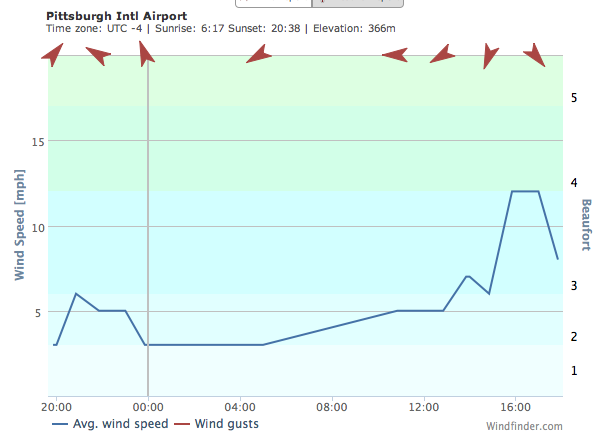
The red arrows at the top indicated wind direction. We had put into the water right at the time that the winds were changing direction. They blew from the East in late morning and shifted round to the Northwest by about 4pm (=16:00). When we ventured up the Allegheny, the winds had been roughly North NorthEast, which is why we could manage to get anywhere at all. When they shifted to the North, they would no longer reach the water on the Allegheny, which is reflected in our experience of losing the wind when we arrived at PNC Park.
It has been an interesting day sailing, with good moments and awkward moments. It might be the sort of experience you don't want to repeat too often. At the end of the day, I thanked Tom and Jean for sailing with me. Would they like to come again? Yes, they both said, and they said it in unison, without hesitation, so I really do believe them.
John D. Norton
Back to main
